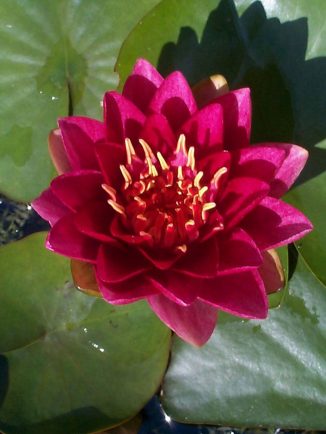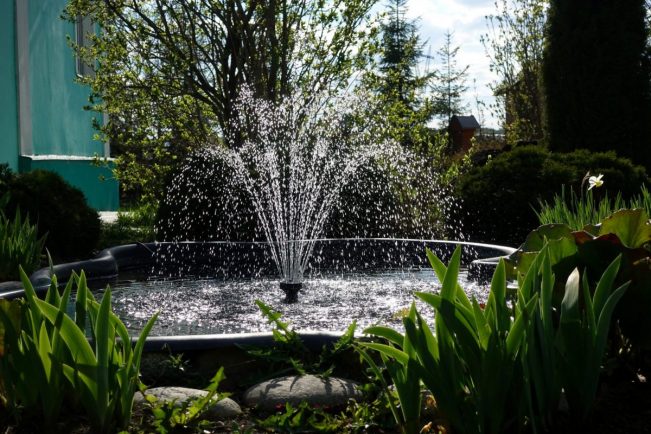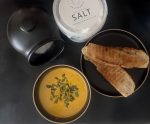Even if you’re short of space, you can still add a cool, calm feature to an urban garden, says Hannah Stephenson.
Fancy a water feature in your garden but don’t have much space?
Don’t worry, you can still enjoy a tranquil rippling pool or fountain to provide an eye-catching highlight, a magnet for wildlife, and give a home to aquatic plants which will add colour and form to the scene.
Keep it still
The easiest container pool is one where the water remains still – which you can make any size for any space, and won’t need any excavation work.
As long as your container is sealed, with the drain holes plugged with rubber stoppers and pond sealant and a plastic liner, you should be good to go.
Many containers can be used for the feature, from a basic half barrel, which can be converted into a miniature pond, to old basins, galvanised containers and more modern reflective steel bowls. Even ceramic pots filled will water lilies will create an oriental-style feature.
Ideally, the size should be no less than 45cm (18in) across and it should hold at least 23 litres (five gallons) of water.
Fountains and waterfalls
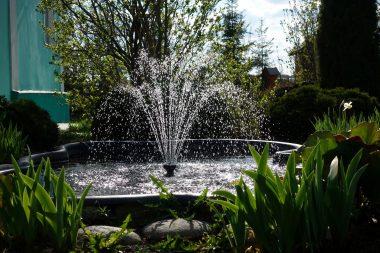 A garden fountain. Picture by iStock/PA.
A garden fountain. Picture by iStock/PA.If you want a fountain, it could be placed in a pot above ground, or you could submerge it in an underground container.
The main thing with fountains is to keep them in scale with the container.
You’ll need a submersible pump, which will need to be placed inside the pot or other reservoir for the fountain once it is in place, then fill the pot with water, test the pump and adjust the flow.
Just remember if you are creating a fountain from scratch, even just a small one where water bubbles gently over the edge of a pot, make sure the container is frost-proof and waterproof.
If you’re using a ceramic or wooden container, it’s best to use a butyl liner to seal it.
Top up the containers and reservoirs if the water becomes low.
Ready-made waterfall kits are widely available, some which have LED lighting, which are self-contained, don’t need to be connected to a water source and come with a reservoir which you just fill up.
You’ll need an outdoor electrical supply for the pump to circulate water, which is then fed back into the reservoir and circulated again from there.
What about planting?
“You can still have the assortment of plants you would find in a pond with a reduced-sized water feature – you just need to think ‘small’,” says Stephen Buss, marketing manager of water garden specialist Oase UK (oase.com/en).
“Make sure you have a good mix of oxygenators – underwater plants – and ornamental plants that cover the surface of the water with their floating leaves and root at the bottom of the water.”
Most ornamentals are grown in aquatic planting baskets lined with hessian and filled with a heavy loam soil, then covered with grit to stop the soil from muddying the water, he observes.
“Planting baskets also help to stop the spread of vigorous growing plants. With aquatic plants, less is more. Try three to start with as you need to be able to see open water around them.”
Keep algae at bay
Oxygenator plants are essential in keeping algae at bay and are the most beneficial plants in any water feature eco-system, says Buss.
Curly Pondweed (Potamogeton crispus) is a British native with wavy-edged deep green leaves that make it look a bit like seaweed. Although it’s a submerged plant, it produces small pink-white flowers above the surface in early summer.
Use colour
Water forget-me-not (Myosotis scorpioides) is low growing and produces masses of small sky-blue flowers with yellow centres from May to September.
It’s also native to the UK and is best grown in shallow water of 10cm deep. When the flowers fade, cut them back to encourage more, but in the autumn, let the tips grow, as these become plants the following year, he adds.
Other colourful types include the water violet, a British native plant with white-mauve flowers that appear in May-June.
Don’t forget water lilies
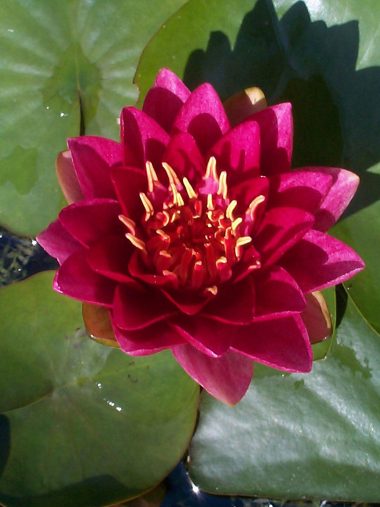 Water lily Nymphaea ‘Perry’s Baby Red’. Picture by Oase/PA
Water lily Nymphaea ‘Perry’s Baby Red’. Picture by Oase/PAThe show-stoppers of the pond world need daily sunlight, which is worth remembering when positioning your water feature, and they don’t like being splashed, so are best suited to still water.
There are a number of dwarf and miniature varieties that like the shallower environment of a compact water habitat. Try Nymphaea ‘Perry’s Baby Red’ with its dark green and maroon leaves and deep crimson flowers from May to September that attract bees, butterflies and hoverflies, Buss suggests.
Whatever plants you end up choosing, some may prefer different depths of water to grow in. A simple way to raise them to the right level is to create submerged pedestals, by using bricks, stones or upturned flower pots – anything that doesn’t float.
Location is key
Ideally, put your water feature where you’ll get both sun and shade during the day (although water lilies flower better if they get three to five hours of direct sunlight daily).

